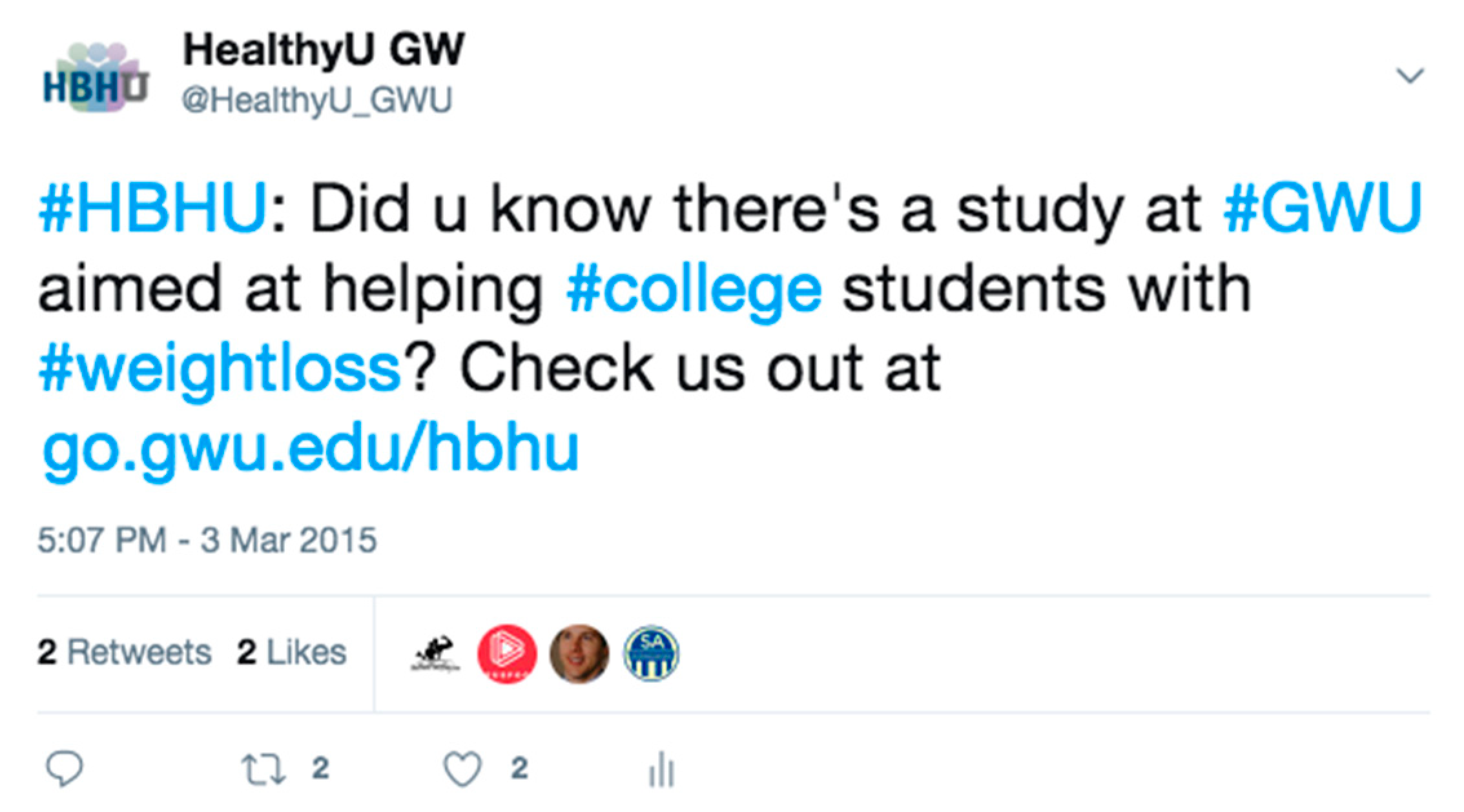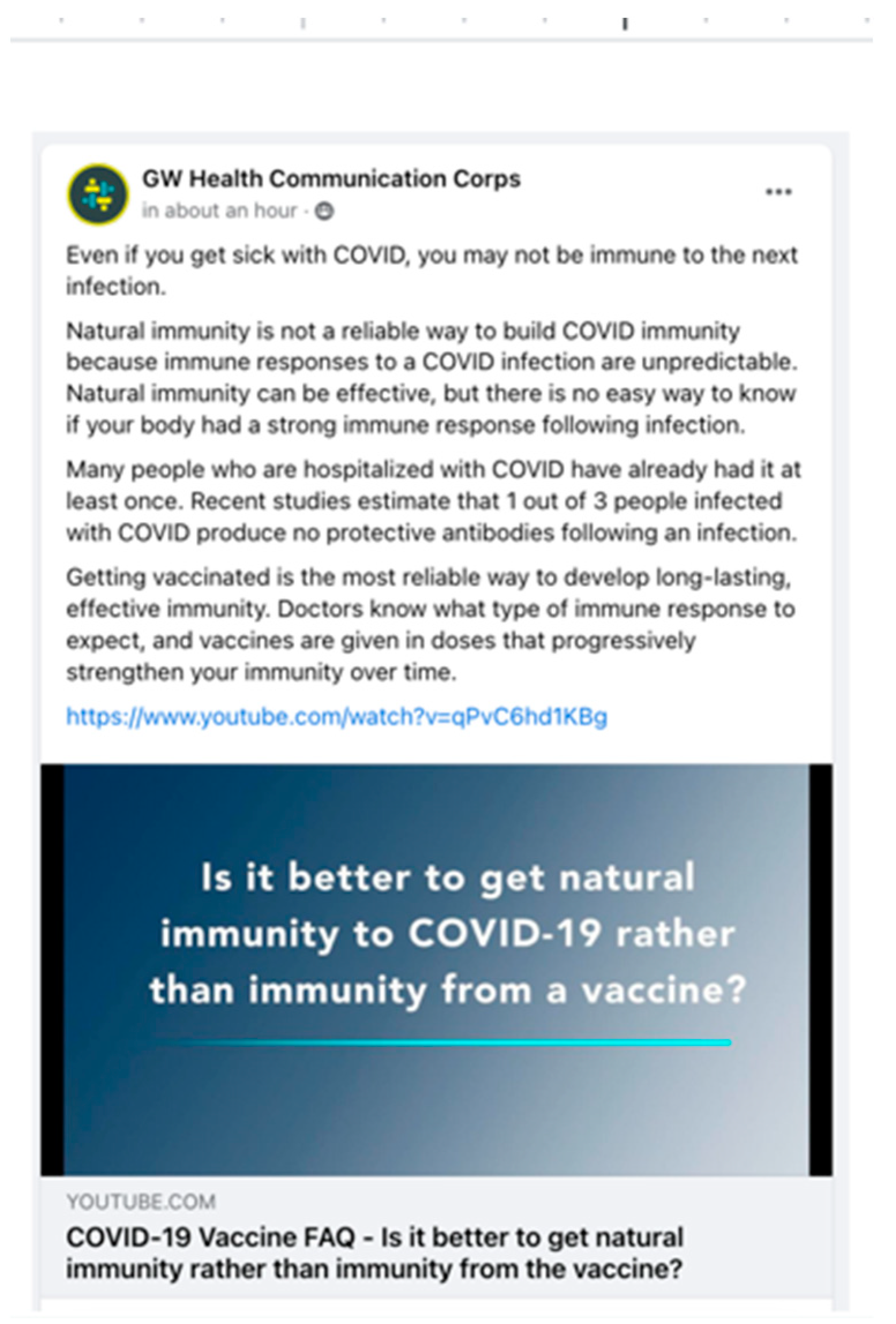Digital Media for Behavior Change: Review of an Emerging Field of Study
Abstract
:1. Introduction
1.1. Brief Summary of Current Digital Health Research
1.2. Overview of Digital Interventions
1.3. Examples of Digital Health Research
1.4. Evidence on Digital Media for Behavior Change
2. Methods
2.1. Examples of Methods to Deliver Digital Media Campaigns for Behavior Change
2.2. Examples of Digital Media Methods in Formative Research
2.3. Examples of Digital Media Methods for Evaluation Research
3. Results
3.1. Use Cases
3.1.1. Use Case #1: Social Media to Deliver Weight Loss Information to Young Adults on University Campuses
3.1.2. Use Case #2: Nigeria Social Media to Promote COVID-19 Vaccination Impact Evaluation
3.1.3. Use Case #3: Randomized Controlled Trial to Assess the Efficacy of Facebook Groups for COVID-19 Vaccination Uptake
3.1.4. Use Case #4: Pilot Randomized Controlled Trial to Evaluation the Efficacy of Anti-Vaping Advertisements
4. Discussion
5. Conclusions
Author Contributions
Funding
Informed Consent Statement
Data Availability Statement
Conflicts of Interest
References
- Seiler, J.; Libby, T.; Jackson, E.; Lingappa, J.; Agha, S.; Evans, W.D. Effectiveness of Social Media-based Behavioral Interventions in Low and Middle Income Countries: A Systematic Review. J. Med. Internet Res. 2022; in press. [Google Scholar]
- Pew Research Center, April 2021, Social Media Use in 2021. Available online: file:///C:/Users/wdevans/Downloads/PI_2021.04.07_Social-Media-Use_FINAL.pdf (accessed on 11 April 2022).
- Nesi, J.; Telzer, E.H.; Prinstein, M.J. Adolescent Development in the Digital Media Context. Psychol. Inq. 2020, 31, 229–234. [Google Scholar] [CrossRef] [PubMed]
- Whittaker, R.; McRobbie, H.; Bullen, C.; Rodgers, A.; Gu, Y.; Dobson, R. Mobile phone text messaging and app-based interventions for smoking cessation. Cochrane Database Syst. Rev. 2019, 2019, CD006611. [Google Scholar] [CrossRef] [PubMed]
- Whiteley, J.A.; Tjaden, A.H.; Bailey, C.P.; Faro, J.; DiPietro, L.; Hayman, L.L.; Napolitano, M.A. Engagement with Digital Weight Loss Intervention Components and Weight Outcomes. 2022; Manuscript under review. [Google Scholar]
- Appel, G.; Grewal, L.; Hadi, R.; Stephen, A.T. The future of social media in marketing. J. Acad. Mark. Sci. 2019, 48, 79–95. [Google Scholar] [CrossRef] [Green Version]
- Hair, E.C.; Kreslake, J.M.; Rath, J.M.; Pitzer, L.; Bennett, M.; Vallone, D. Early evidence of the associations between an anti-e-cigarette mass media campaign and e-cigarette knowledge and attitudes: Results from a cross-sectional study of youth and young adults. Tob. Control 2021. [Google Scholar] [CrossRef] [PubMed]
- Krishnan, N.; Gu, J.; Abroms, L.C. Mobile phone-based messaging for tobacco cessation in low and middle-income countries: A systematic review. Addict. Behav. 2020, 113, 106676. [Google Scholar] [CrossRef]
- Springer, S.; Zieger, M.; Strzelecki, A. The rise of infodemiology and infoveillance during COVID-19 crisis. One Health 2021, 13, 100288. [Google Scholar] [CrossRef]
- Karim, F.; Oyewande, A.; Abdalla, L.F.; Ehsanullah, R.C.; Khan, S. Social Media Use and Its Connection to Mental Health: A Systematic Review. Cureus 2020, 12, e8627. [Google Scholar] [CrossRef]
- Berryman, C.; Ferguson, C.J.; Negy, C. Social Media Use and Mental Health among Young Adults. Psychiatr. Q. 2017, 89, 307–314. [Google Scholar] [CrossRef]
- Evans, W.; Andrade, E.; Pratt, M.; Mottern, A.; Chavez, S.; Calzetta-Raymond, A.; Gu, J. Peer-to-Peer Social Media as an Effective Prevention Strategy: Quasi-Experimental Evaluation. JMIR mHealth uHealth 2020, 8, e16207. [Google Scholar] [CrossRef]
- Andrade, E.L.; Evans, W.D.; Barrett, N.; Edberg, M.C.; Cleary, S.D. Strategies to Increase Latino Immigrant Youth Engagement in Health Promotion Using Social Media: Mixed-Methods Study. JMIR Public Health Surveill. 2018, 4, e71. [Google Scholar] [CrossRef]
- Tulsiani, S.; Ichimiya, M.; Gerard, R.; Mills, S.; Bingenheimer, J.; Hair, E.; Vallone, D.; Evans, W.D. Feasibility of Virtual Lab platform for studying awareness of a health campaign in Facebook among young adults. J. Med. Internet Res. Form. Res. 2022; in press. [Google Scholar]
- Yang, K.; Liu, Y.; Huang, S.; Ma, X.; Lu, F.; Ou, M. Effectiveness of interventions involving social networks for self-management and quality of life in adults with diabetes. JBI Database Syst. Rev. Implement. Rep. 2020, 18, 163–169. [Google Scholar] [CrossRef] [PubMed]
- Khaylis, A.; Yiaslas, T.; Bergstrom, J.; Gore-Felton, C. A Review of Efficacious Technology-Based Weight-Loss Interventions: Five Key Components. Telemed. e-Health 2010, 16, 931–938. [Google Scholar] [CrossRef] [Green Version]
- Scherr, A.E.S.; Brenchley, K.J.M.; Gorin, A.A. Examining a Ripple Effect: Do Spouses’ Behavior Changes Predict Each Other’s Weight Loss? J. Obes. 2013, 2013, 297268. [Google Scholar] [CrossRef]
- Green, D.P.; Gerber, A.S.; Nickerson, D.W. Getting Out the Vote in Local Elections: Results from Six Door-to-Door Canvassing Experiments. J. Politi 2003, 65, 1083–1096. [Google Scholar] [CrossRef]
- Ichimiya, M.; Gerard, R.; Mills, S.; Brodsky, A.; Evans, W.D. Measurement of Dose and Response for Smoking Behavior Change Interventions in the Digital Age: A Systematic Review. J. Med. Internet Res. 2022. [Google Scholar] [CrossRef]
- Napolitano, M.A.; Hayes, S.; Bennett, G.G.; Ives, A.K.; Foster, G.D. Using facebook and text messaging to deliver a weight loss program to college students. Obesity 2013, 21, 25–31. [Google Scholar] [CrossRef] [PubMed]
- Thrul, J.; Tormohlen, K.N.; Meacham, M.C. Social media for tobacco smoking cessation intervention: A review of the literature. Curr. Addict. Rep. 2019, 6, 126–138. [Google Scholar] [CrossRef]
- Gu, J.; Dor, A.; Li, K.; Broniatowski, D.A.; Hatheway, M.; Fritz, L.; Abroms, L.C. The impact of Facebook’s vaccine misinformation policy on user endorsements of vaccine content: An interrupted time series analysis. Vaccine 2022, 40, 2209–2214. [Google Scholar] [CrossRef] [PubMed]
- Agha, S.; Chine, A.; Lalika, M.; Pandey, S.; Seth, A.; Wiyeh, A.; Seng, A.; Rao, N.; Badshah, A. Drivers of COVID-19 Vaccine Uptake amongst Healthcare Workers (HCWs) in Nigeria. Vaccines 2021, 9, 1162. [Google Scholar] [CrossRef]
- Hales, C.M.; Carroll, M.D.; Fryar, C.D.; Ogden, C.L. Prevalence of Obesity and Severe Obesity among Adults: United States, 2017–2018; CDC National Center for Health Statistics: Hyattsville, MD, USA, 2020; Volume 360, pp. 1–8.
- Winpenny, E.M.; Smith, M.; Penney, T.; Foubister, C.; Guagliano, J.M.; Love, R.; Clifford Astbury, C.; van Sluijs, E.M.; Corder, K. Changes in physical activity, diet, and body weight across the education and employment transitions of early adulthood: A systematic review and meta-analysis. Obes. Rev. 2020, 21, e12962. [Google Scholar] [CrossRef] [Green Version]
- Winpenny, E.M.; Van Sluijs, E.M.F.; White, M.; Klepp, K.-I.; Wold, B.; Lien, N. Changes in diet through adolescence and early adulthood: Longitudinal trajectories and association with key life transitions. Int. J. Behav. Nutr. Phys. Act. 2018, 15, 86. [Google Scholar] [CrossRef] [PubMed]
- Bennett, M.; Whiteley, J.A.; Gu, J.; Gaminian, A.; Napolitano, M.A. A qualitative investigation of the need for and feasibility of weight loss programs on university campuses. Obes. Res. Clin. Pract. 2022, 16, 72–81. [Google Scholar] [CrossRef] [PubMed]
- Lynch, S.; Hayes, S.; Napolitano, M.; Hufnagel, K. Availability and Accessibility of Student-Specific Weight Loss Programs and Other Risk Prevention Health Services on College Campuses. JMIR Public Health Surveill. 2016, 2, e29. [Google Scholar] [CrossRef] [PubMed]
- Napolitano, M.A.; Whiteley, J.A.; Mavredes, M.N.; Faro, J.; DiPietro, L.; Hayman, L.L.; Neighbors, C.J.; Simmens, S. Using social media to deliver weight loss programming to young adults: Design and rationale for the Healthy Body Healthy U (HBHU) trial. Contemp. Clin. Trials 2017, 60, 1–13. [Google Scholar] [CrossRef]
- Whiteley, J.A.; Faro, J.M.; Mavredes, M.; Hayman, L.L.; Napolitano, M.A. Application of social marketing to recruitment for a digital weight management intervention for young adults. Transl. Behav. Med. 2020, 11, 484–494. [Google Scholar] [CrossRef]
- Moreno, M.A.; Goniu, N.; Moreno, P.S.; Diekema, D. Ethics of Social Media Research: Common Concerns and Practical Considerations. Cyberpsychology, Behav. Soc. Netw. 2013, 16, 708–713. [Google Scholar] [CrossRef] [Green Version]
- The Diabetes Prevention Program Research Group. The diabetes prevention program (DPP): Description of lifestyle intervention. Diabetes Care 2002, 25, 2165–2171. [Google Scholar] [CrossRef] [Green Version]
- The Diabetes Prevention Program Research Group. The Diabetes Prevention Program, Design and methods for a clinical trial in the prevention of type 2 diabetes. Diabetes Care 1999, 22, 623–634. [Google Scholar] [CrossRef] [Green Version]
- Napolitano, M.A.; Whiteley, J.A.; Mavredes, M.; Tjaden, A.H.; Simmens, S.; Hayman, L.L.; Faro, J.; Winston, G.; Malin, S.; DiPietro, L. Effect of tailoring on weight loss among young adults receiving digital interventions: An 18 month randomized controlled trial. Transl. Behav. Med. 2021, 11, 970–980. [Google Scholar] [CrossRef]
- Arnold, J. Communication, Persuasion, and Facebook: Measuring the Effectiveness of Facebook Posts in the Healthy Body, Healthy U Study. Master’s Thesis, George Washington University, Washington, DC, USA, 2002. [Google Scholar]
- McGuire, W.J. Input and Output Variables Currently Promising for Constructing Persuasive Communications. In Public Communication Campaigns; Rice, R.E., Atkin, C.K., Eds.; SAGE Publications, Inc.: Thousand Oaks, CA, USA, 2001; pp. 22–48. [Google Scholar] [CrossRef]
- The Online Advertising Guide [TOAG]. (n.d.). Facebook Engagement Rate Calculator. Available online: https://theonlineadvertisingguide.com/ad-calculators/facebook-engagement-rate-calculator/ (accessed on 22 May 2022).
- Betsch, C.; Schmid, P.; Heinemeier, D.; Korn, L.; Holtmann, C.; Böhm, R. Beyond confidence: Development of a measure assessing the 5C psychological antecedents of vaccination. PLoS ONE 2018, 13, e0208601. [Google Scholar] [CrossRef] [Green Version]
- Evans, W.D.; Bingenheimer, J.B.; Ndiaye, K.; Long, M.; Rao, N.; Dinate, D.; Agha, S. Design and Impact Evaluation of a Social Media Campaign to Promote COVID-19 Vaccination among Health Care Workers in Nigeria. 2022; Manuscript under review. [Google Scholar]
- Baack, B.N.; Abad, N.; Yankey, D.; Kahn, K.E.; Razzaghi, H.; Brookmeyer, K.; Kolis, J.; Wilhelm, E.; Nguyen, K.H.; Singleton, J.A. COVID-19 Vaccination Coverage and Intent Among Adults Aged 18–39 Years—United States, March–May 2021. MMWR. Morb. Mortal. Wkly. Rep. 2021, 70, 928–933. [Google Scholar] [CrossRef] [PubMed]
- Cantrell, J.; Bingenheimer, J.; Tulsiani, S.; Hair, E.C.; Vallone, D.; Mills, S.; Gerard, R.; Evans, W.D. Design and pilot evaluation of a virtual experimental protocol to assess anti-tobacco digital campaign advertising exposure. Digit. Health, 2022; in press. [Google Scholar]
- Kwasnicka, D.; Dombrowski, S.U.; White, M.; Sniehotta, F.F. Theoretical explanations for maintenance of behaviour change: A systematic review of behaviour theories. Health Psychol. Rev. 2015, 10, 277–296. [Google Scholar] [CrossRef] [PubMed]
- van Kessel, R.; Wong, B.L.H.; Clemens, T.; Brand, H. Digital health literacy as a super determinant of health: More than simply the sum of its parts. Internet Interv. 2022, 27, 100500. [Google Scholar] [CrossRef] [PubMed]




Publisher’s Note: MDPI stays neutral with regard to jurisdictional claims in published maps and institutional affiliations. |
© 2022 by the authors. Licensee MDPI, Basel, Switzerland. This article is an open access article distributed under the terms and conditions of the Creative Commons Attribution (CC BY) license (https://creativecommons.org/licenses/by/4.0/).
Share and Cite
Evans, W.D.; Abroms, L.C.; Broniatowski, D.; Napolitano, M.A.; Arnold, J.; Ichimiya, M.; Agha, S. Digital Media for Behavior Change: Review of an Emerging Field of Study. Int. J. Environ. Res. Public Health 2022, 19, 9129. https://doi.org/10.3390/ijerph19159129
Evans WD, Abroms LC, Broniatowski D, Napolitano MA, Arnold J, Ichimiya M, Agha S. Digital Media for Behavior Change: Review of an Emerging Field of Study. International Journal of Environmental Research and Public Health. 2022; 19(15):9129. https://doi.org/10.3390/ijerph19159129
Chicago/Turabian StyleEvans, William Douglas, Lorien C. Abroms, David Broniatowski, Melissa A. Napolitano, Jeanie Arnold, Megumi Ichimiya, and Sohail Agha. 2022. "Digital Media for Behavior Change: Review of an Emerging Field of Study" International Journal of Environmental Research and Public Health 19, no. 15: 9129. https://doi.org/10.3390/ijerph19159129
APA StyleEvans, W. D., Abroms, L. C., Broniatowski, D., Napolitano, M. A., Arnold, J., Ichimiya, M., & Agha, S. (2022). Digital Media for Behavior Change: Review of an Emerging Field of Study. International Journal of Environmental Research and Public Health, 19(15), 9129. https://doi.org/10.3390/ijerph19159129






